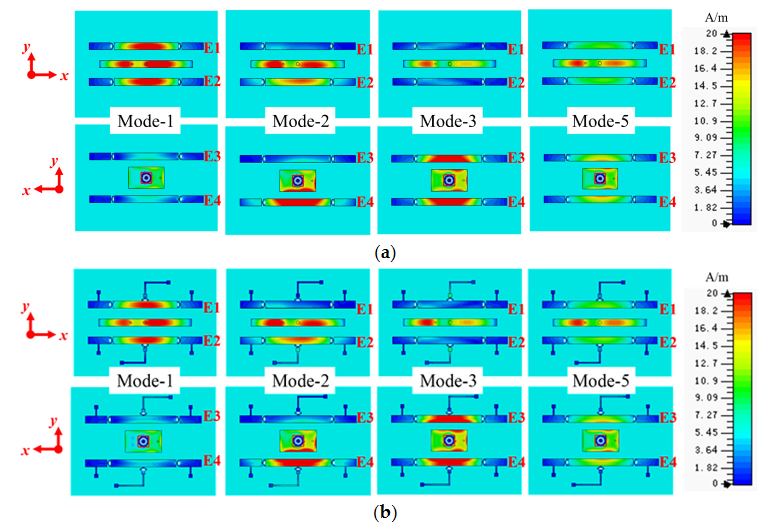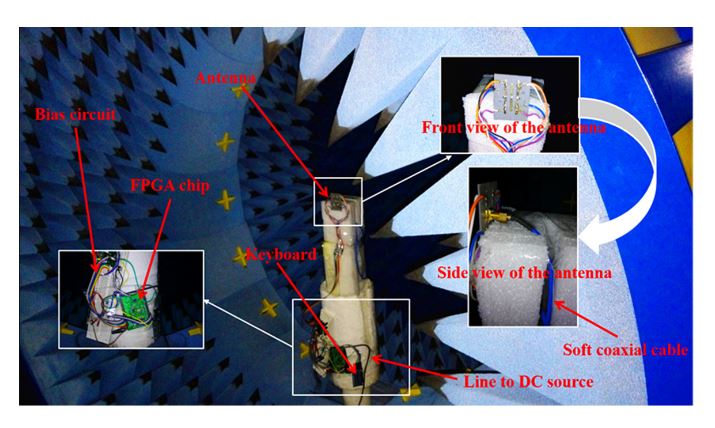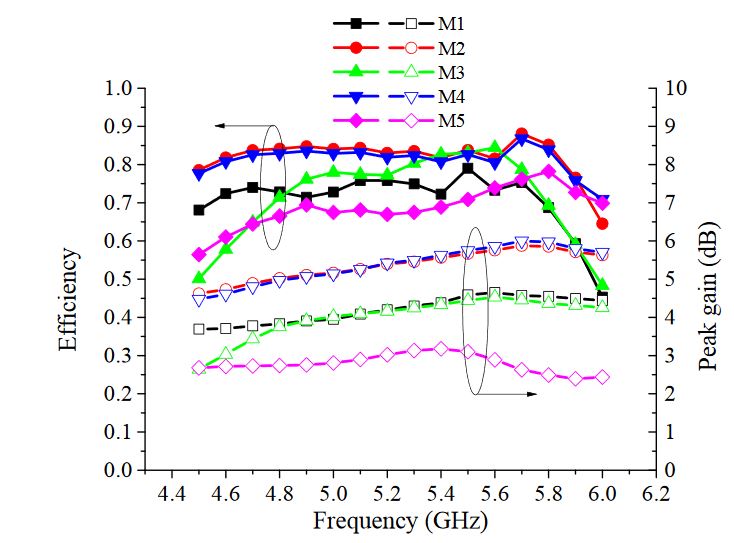ABSTRACT
A compact reconfigurable antenna with an omnidirectional mode and four directional modes is proposed. The antenna has a main radiator and four parasitic elements printed on a dielectric substrate. By changing the status of diodes soldered on the parasitic elements, the proposed antenna can generate four directional radiation patterns and one omnidirectional radiation pattern. The main beam directions of the four directional modes are almost orthogonal and the four directional beams can jointly cover a 360° range in the horizontal plane, i.e., the main radiation plane of omnidirectional mode.
The whole volume of the antenna and the control network is approximately 0.70 λ x 0.53 λ x 0.02 λ, where λ is the wavelength corresponding to the center frequency. The proposed antenna has a simple structure and small dimensions under the requirement that the directional radiation patterns can jointly cover the main radiation plane of the omnidirectional mode, therefore, it can be used in smart wireless sensor systems for different application scenarios.
ANTENNA DESIGN AND ANALYSIS

Figure 2. Surface current distribution at 5.5 GHz of the proposed reconfigurable antenna: (a) without bias network and (b) with bias network
Because the antenna radiation mechanism can be identified by analyzing the surface currents distributions, the surface current distributions at different modes of the proposed reconfigurable antenna are shown in Figure 2 to describe its radiation mechanisms. From these figures, we can see that the current distributions at a specific mode are similar whether the bias network exists or not. In different operation modes, the current intensity on each parasitic element is different.

Figure 4. Simulated reflection coefficients of the proposed antenna with and without bias network
To show the effect of the bias network, reflection coefficients and radiation patterns of the proposed antenna with and without bias network are shown in Figures 4 and 5 respectively. BN represents bias network in the figures. From these figures, we can see that there are few differences between the two situations, with and without bias network, both in the reflection coefficient and radiation pattern.
RESULTS AND DISCUSSIONS

Figure 10. Scene layout of the antenna with SATIMO Antenna Measurement System
The far-field patterns are measured in a microwave anechoic chamber with a SATIMO Antenna Measurement System, as shown in Figure 10. Regarding the pattern of Mode-3, it radiates towards the -z direction, where a coaxial cable exists to feed the antenna. Even though the feeding cable has been modeled on the practically SMA connector in the simulation, the coaxial cable connected to the measurement equipment may have serious effects on the radiation pattern if the antenna is installed vertically to the whole cable.

Figure 12. Measured efficiencies and peak gains of the proposed antenna corresponding to different modes
The measured efficiencies and peak gains corresponding to different radiation modes are shown in Figure 12. When the proposed reconfigurable antenna operates at all five modes, the measured efficiencies are more than 60% in the 4.6 GHz-5.9 GHz operation frequency band. The peak gains at Modes-2/4, Modes-1/3, and Mode-5 are from 5 dB to 6 dB, from 3.5 dB to 4.5 dB, and from 2.5 dB to 3 dB, respectively, in the operation band.
CONCLUSIONS
In this paper, a compact reconfigurable antenna with an omnidirectional mode and four directional modes is proposed. The patterns of the four directional modes can jointly cover the main radiation plane of the omnidirectional mode, which means that the main goal of the proposed work is achieved. Compared to the radiator array scheme that can also achieve this goal, the proposed method with multiple parasitic elements needs only one radiator and no power divider networks, thus, the dimensions can be small.
However, the messy DC control wires may affect the radiation pattern. In practical applications, the DC control wires should be integrated with the antenna according to the given situation. The proposed antenna can be used in smart wireless sensor systems of different application scenarios, especially DoA estimation systems in the C-band.
Source: University of Electronic Science
Authors: Ren Wang | Bing-zhong Wang | Wei-Ying Huang | Xiao Ding
>> More Wireless Sensor Networks Projects Abstract for Engineering Students